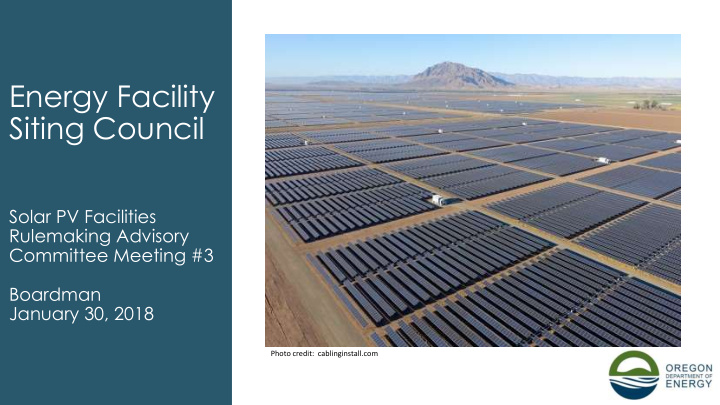



Energy Facility Siting Council Solar PV Facilities Rulemaking Advisory Committee Meeting #3 Boardman January 30, 2018 Photo credit: cablinginstall.com
Agenda • Overview and Introductions • Discussion of issues/potential standards specific to solar PV facilities • Public comment • Wrap up and next step
Overview of meeting • All discussion is prospective, we are not proposing any changes at this time. • We are seeking input, consensus is not required. • Please identify yourself when providing comment for the record. • An audio recording and notes of the meeting will be made available
Introductions • Name • Organization • Interest in rulemaking
Issues/potential standards The department is seeking input on potential issues related to solar PV facilities to determine if specific standards may be required. Toxicity and disposal of solar panels Impacts to wildlife and wildlife habitat • Impacts related to glare from panels and system components • Impacts related to changes in microclimate near solar facilities (e.g. the “heat island effect”) • Any other issues identified by RAC members
Impacts related to glare What is glare? “Glare” includes a brief or extended flash of sunlight reflected from the surface of a solar panel or other system component. Glare has the potential to cause discomfort or temporary blindness in an observer. Sunlight reflects off of solar panels being assembled near the Pendleton airport (E.J. Harris, The East Oregonian.)
Impacts related to glare Evidence suggests some potential for impacts. With anti-reflective coating, the average solar panel reflects as little as 2% of incoming sunlight, similar to smooth water. Intensity of glare is influenced by the arrangement of panels and angle of the sun. Percentage of reflection light from the surface of a PV module as a function of angle. (Anurag et al., 2017)
Impacts related to glare While concerns about impacts related to glare are common, few jurisdictions regulate it specifically. ODOT and other jurisdictions have “solar highway” programs which have not impacted safety. Solar facilities have also been successfully sited on airports. FAA The Oregon Solar Highway Demonstration Project located at the regulations require glare analysis for interchange of I-5 and I-205 near Portland (ODOT, 2016.) airport-based facilities.
Impacts related to glare Current standards may address some impacts: • Public Service Standard (OAR 345-022-0110.) • Recreation (OAR 345-022-0100) • Scenic Resources (OAR 345-022-0080) • Protected Areas (OAR 345-022-0040) These standards do not apply to potential impacts to private residences or landowners.
DISCUSSION Are you aware of concerns related to this issue? How are potential impacts currently being addressed? What are best ways to mitigate or avoid adverse impacts?
Impacts related to microclimate effects Some evidence suggests large-scale solar PV facilities have the potential to effect local air temperatures, humidity, pressure, and wind speed. Microclimate effects are driven by changes in surface reflectivity (albedo), shading, and roughness, as well as changes in vegetation. Theoretical differences between vegetated ecosystem (A) and solar facility (B). Heat is captured and stored in soils (orange arrows). Plants dissipate heat Some concerns have been raised about release (red) through evapotranspiration (blue). Solar panels convert some the impacts these microclimate effects energy to electricity (purple) and reradiate some as heat (brown). (Barron- Gafford et al., 2016.) may have on agriculture.
Impacts related to microclimate effects Size and direction of impacts are highly site specific. Several empirical studies have found small but statistically significant increases in air temperatures near large solar facilities in rural areas. In urban areas, rooftop arrays One study of a solar PV facility in Arizona found average and utility scale facilities may temperatures near facility were 3-4 °C warmer at night than nearby desert lands (Barron-Gifford et al., 2016.) decrease ambient temperatures.
Impacts related to microclimate effects Some practices may minimize adverse impacts. These include: • Creating setbacks from temperature sensitive areas • Limiting vegetation losses during construction and operation of the facility A dual-use solar facility and sheep pasture near OSU has found improved forage production under solar panels (Adeh, Selker & Higgins, 2018.)
How do current standards address microclimate effects? • Under ORS 215.296, a photovoltaic solar power generating facility may only be approved on EFU land if it does not force a significant change in or significantly increase the cost of accepted farm or forest practices on surrounding lands. • In order to approve a goal exception, the Land Use Standard (OAR 345-022-0030) requires Council to find that the following standards are met: • The significant environmental, economic, social and energy consequences anticipated as a result of the proposed facility have been identified and adverse impacts will be mitigated in accordance with rules of the Council applicable to the siting of the proposed facility. • The proposed facility is compatible with other adjacent uses or will be made compatible through measures designed to reduce adverse impacts.
Impacts related to microclimate effects Potential Discussion Items: Are you aware of concerns related to this issue? How are potential impacts currently being addressed? What are best ways to mitigate or avoid adverse impacts?
Other issues?
Public comment
Wrap-up and next steps
Recommend
More recommend